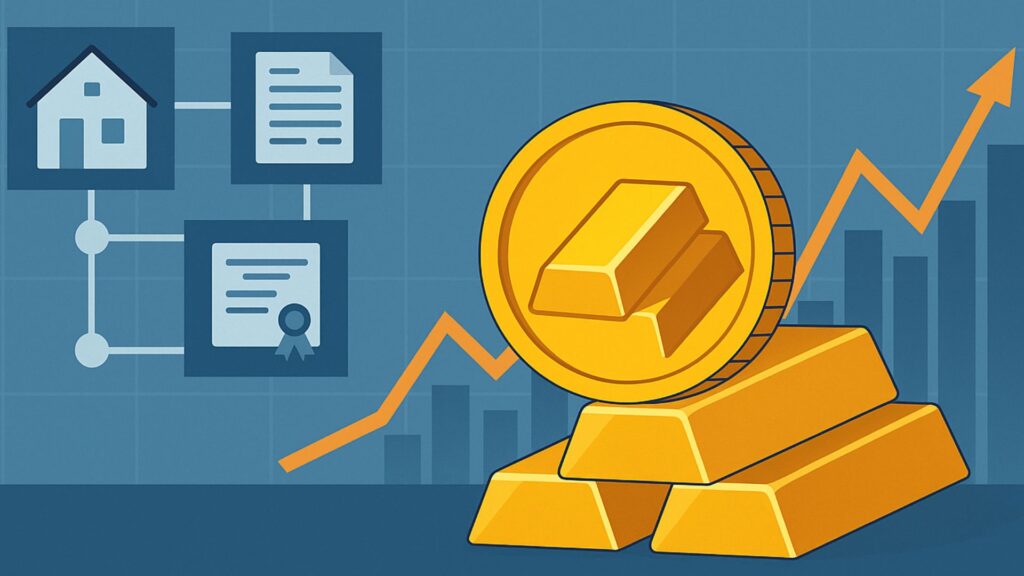In today’s unpredictable financial climate, investors are searching for stability. While crypto offers speed and innovation, its volatility often raises concerns.
That’s why real-world assets, or RWAs, are drawing renewed attention. These are physical or traditional financial assets brought onto the blockchain.
Gold, a long-trusted store of value, is now being tokenised and used in new ways through decentralised platforms. In combining real-world reliability with digital efficiency, RWAs are offering a sense of balance in uncertain times.
The Growing Importance of Tokenised Real World Assets
Real World Assets (RWAs) refer to tangible or traditional assets like property, gold, bonds, invoices, and company shares that are represented as tokens on a blockchain.
This allows them to be traded and used in crypto markets with the security and transparency that blockchain offers. Rather than relying solely on digital-native tokens, RWAs give users access to assets with value already established in the traditional economy.
One of the most practical benefits of RWAs is accessibility. Buying a house or investing in gold typically requires a large amount of money, but tokenisation allows people to own fractions of these assets.
It opens the door for smaller investors to get involved. This is similar to buying a slice of pizza instead of the entire pie.
RWAs also improve liquidity. Selling physical assets usually involves time and paperwork, but once tokenised, these assets can be traded around the clock on digital platforms.
This kind of liquidity is more aligned with the expectations of crypto users who are used to fast, continuous transactions.
Blockchain adds another important layer, security and transparency. Every transaction is recorded on a public ledger that cannot be altered, ensuring clear proof of ownership and history.
For investors, this removes many of the uncertainties and inefficiencies found in traditional systems.
Including RWAs in a crypto portfolio offers better risk management. As digital assets remain volatile, having a portion of investments in more stable, real-world instruments can provide a cushion.
Even better, some of these assets, such as real estate or invoices, can be used to earn passive income when lent through blockchain platforms. This added utility makes RWAs a more appealing option in periods of financial stress.
How Gold Supports Stability During Uncertain Conditions
When traditional markets become unstable, investors tend to move their capital into assets that are less likely to lose value.
Gold has played this role for centuries, acting as a store of wealth in times of crisis. With recent price surges and ongoing market uncertainty, gold is once again seen as a safe option.
But gold has its limits. Unlike bonds or savings accounts, gold does not generate income. It only profits if sold at a higher price.
While this strategy can work during market spikes, like those following the 2008 crash or the recent pandemic, gold often remains flat for long periods. That makes it less attractive compared to income-generating assets like government bonds.
This is where decentralised finance may offer a solution. By bringing gold onto the blockchain in tokenised form, it becomes easier to manage and use.
More importantly, there is potential to make it more productive. DeFi platforms could eventually support yield-generating uses for tokenised gold, making it more appealing to modern investors.
Currently, most gold tokens on the market resemble digital versions of ETFs. Tether Gold (XAUT) and Paxos Gold (PAXG) are examples. They are backed by physical gold and allow digital ownership. However, they do not offer any yield.
While this provides convenience and security, it doesn’t align with the expectations of DeFi users who are used to earning rewards on their holdings.
This may explain why gold tokens are still relatively limited in reach. Tether Gold has a market cap of around $835 million, and Paxos Gold around $799 million.
That combined figure is still only a small fraction compared to USDT, which remains the dominant asset in many DeFi strategies. The absence of earning potential could be one of the reasons gold tokens are not more widely adopted.
Despite this, gold remains important. In a portfolio, it adds stability and reduces exposure to extreme market shifts. It protects wealth rather than growing it quickly.
If DeFi platforms can find a reliable way to generate income from gold holdings, this traditional asset could gain much more relevance in the digital space.
Conclusion
Tokenised real-world assets like gold are gaining relevance as the gap between traditional finance and blockchain technology narrows. They offer a stable foundation within the crypto market. Gold, in particular, remains a trusted safeguard during economic uncertainty.
Although it currently lacks income-generating functions, the evolving DeFi landscape may soon change that. For now, RWAs help balance risk and preserve value, making them a smart addition to any investor’s toolkit when markets become unpredictable.
Editor: Lydicius

